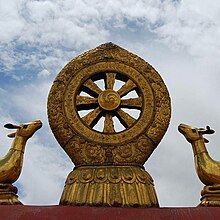You are currently logged-out. You can log-in or create an account to see more talks, save favorites, and more. more info
Noble Eightfold Path Talks

The Noble Eightfold Path (Sanskrit: आर्याष्टाङ्गमार्ग, romanized: āryāṣṭāṅgamārga) or Eight Right Paths (Sanskrit: अष्टसम्यङ्मार्ग, romanized: aṣṭasamyaṅmārga) is an early summary of the path of Buddhist practices leading to liberation from samsara, the painful cycle of rebirth, in the form of nirvana.
The Eightfold Path consists of eight practices: right view, right resolve, right speech, right conduct, right livelihood, right effort, right mindfulness, and right samadhi ('meditative absorption or union'; alternatively, equanimous meditative awareness).
In early Buddhism, these practices started with understanding that the body-mind works in a corrupted way (right view), followed by entering the Buddhist path of self-observance, self-restraint, and cultivating kindness and compassion; and culminating in dhyana or samadhi, which reinforces these practices for the development of the body-mind. In later Buddhism, insight (prajñā) became the central soteriological instrument, leading to a different concept and structure of the path, in which the "goal" of the Buddhist path came to be specified as ending ignorance and rebirth.
The Noble Eightfold Path is one of the principal summaries of the Buddhist teachings, taught to lead to Arhatship. In the Theravada tradition, this path is also summarized as sila (morality), samadhi (meditation) and prajna (insight). In Mahayana Buddhism, this path is contrasted with the Bodhisattva path, which is believed to go beyond Arhatship to full Buddhahood.
In Buddhist symbolism, the Noble Eightfold Path is often represented by means of the dharma wheel (dharmachakra), in which its eight spokes represent the eight elements of the path.
| Title | Speaker | |
|---|---|---|
Right Effort and Right ThoughtSerial: BZ-00026A Saturday Lecture Right Effort, Right Thought, Noble Eightfold Path, Study, Focus, Daily Life,... |
Nov 15 1980 Berkeley Zen Center |